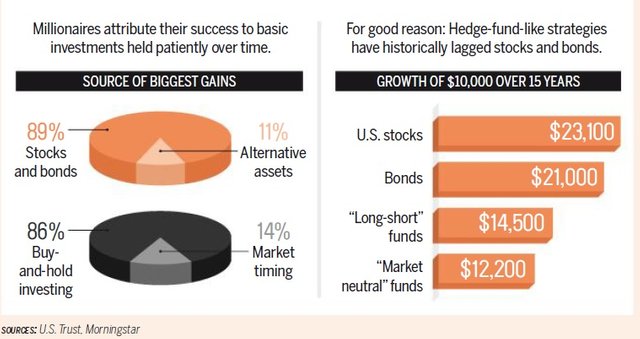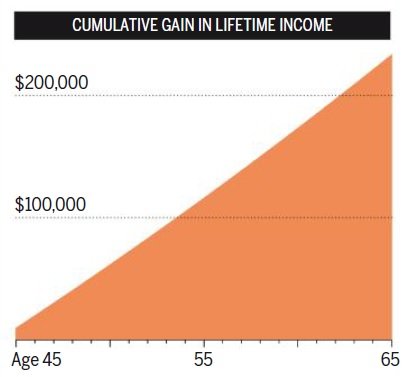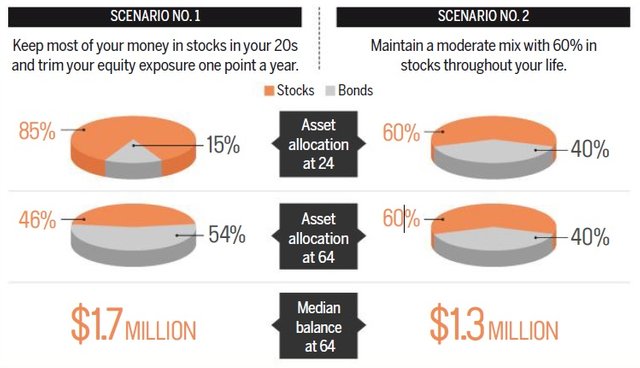HOW TO REACH. | Part ONE.
MILLION
Your goal isn’t to live like the 1%. It’s to achieve 100% of the life that matters to you. Steal a page from today’s millionaires and learn how to plot your best route to financial freedom.

WHEN YOU THINK of millionaires, words like “privilege” and “opulence” often come to mind. What about “comfort”? That’s a term more commonly associated with the middle class. But while most American families enjoy creature comforts, they yearn for a more enduring variant—the peace of mind that comes from knowing you have the financial freedom to pursue whatever life you want.
That sense of comfort is more attainable than you might think. The majority of the seven-figure club’s 10 million members come from middle-class households. And one in five high-net-worth Americans grew up poor, according to a survey by U.S. Trust. Contrary to popular belief, inheritance played a small role in their success; more than 80% of their wealth was earned through their jobs, small businesses, and investments.
On the following pages, you’ll learn just how those millionaires maximized their incomes and portfolios to achieve their financial goals (hint: most of them chose to play the smart odds, not roll the dice). You’ll also find how you can put their strategies to work.
The truth is, becoming a millionaire isn’t about living like the 1%. It’s about doing all the little things at work or in your portfolio or in your budget (see the next story on page 60) that can move the dial 1% here and 1% there to achieve your financial goals.
INVEST SMARTER
Millionaires say small moves make the biggest differences in your portfolio.
GET YOUR HEAD IN THE GAME
Building wealth isn’t just about strategy; it’s about having the right mind-set. Sarah Fallaw, founder of Data Points, a behavioral finance research firm that analyzes wealth potential, says the four key traits to making money are frugality, confidence, responsibility, and social indifference—that is, the strength to avoid fads.
“These behaviors are linked to greater wealth potential for people of all ages and incomes,” says Fallaw, advancing the work of her father, Thomas Stanley, coauthor of The Millionaire Next Door. Among 30-year-olds worth at least $100,000, Data Points found that people with “high wealth potential” based on those traits had a median net worth of $300,000, vs. $200,000 for those with “medium potential.”
Here’s how to apply these qualities to your portfolio:
>>BE A CHEAPSKATE. Say you have $150,000andarepaying 1% in investment fees, which is typical for actively managed funds. If you cut costs by just three-quarters of a percentage point, you’ll save $1,125 in fees a year.
Great, right? But this understates the real impact. “It’s not just 1% of assets, but of your potential return,” which is then compounded over time, says investing expert Charles Ellis, author of The Index Revolution. “When you look at it that way, a 1% fee is enormous.” If you earn 7% in the market but pay a 1% fee, you’ll lose nearly 15% of your return. Given those costs, over 30 years $150,000 will grow to $862,000. Cut those expenses to 0.25%, and you’ll have $1.1 million.
Lowering costs by threequarters of a percentage point isn’t that hard with index funds and ETFs. In fact, the median annual expense ratio for passively managed portfolios, is just 0.20%.
>>IGNORE THE CROWDS. There are always big trends on Wall Street, like the recent rise of “liquid alternative” funds, which bring hedge-fund-like tactics to the masses. Yet the path to $1 million involves being disciplined enough to go against the tide.
Just ask millionaires themselves. Contrary to popular belief, the wealthy don’t rely on trendy forms of investing—in fact, only 15% own hedge funds. By contrast, nearly 90% say their biggest success is due to buying and holding basic stocks and bonds, a U.S. Trust survey found.
You don’t need to resort to investment exotica, either, to find ways to boost returns while reducing risk in your portfolio (see next page). Plus, history shows that faddish investments typically don’t pay off in the long term—at least not as much as core holdings (see chart above).
Consider this: Over the past 15 years—a period marked by extreme highs and extreme lows—a plain-vanilla basket of blue-chip U.S. stocks gained 5.8% annually. By comparison, hedge-fund-like “long-short” funds, which are supposed to thrive in such times, gained 3.2 percentage points less. A $500,000 portfolio earning 5.8% a year would grow to $2 million in 25 years. The same portfolio earning three points less wouldn’t even get to $1 million.
Keep Things Simple
Millionaires are often associated with exotic investments, but that’s actually not the case.

>>STICK TO THE PLAN. Confident investors “make decisions without second-guessing or quickly changing their minds,” says Fallaw. This is important because that self-assurance can prevent you from being whipsawed.
Successful investors also have the composure to hang on to—and even buy—“out-of-favor asset classes with poor prior performance,” says financial adviser William Bernstein, author of The Four Pillars of Investing.That is also critical, as Bernstein notes that asset classes “with below-average past returns tend to have higher-than-average future returns.”
Case in point: foreign stocks. After outpacing U.S. stocks from 2000 to 2009, European and emerging-market shares have struggled, mired by everything from China’s slowdown to Brexit to the Zika virus (see “The Case for Going Global” on page 41).
Over the next 10 years, though, foreign equities are expected to outperform U.S. shares by an average of five percentage points a year or more after taxes and inflation, according to Research Affiliates. That’s largely owing to being undervalued for so long.
>>OWN UP TO YOUR MISTAKES. There are going to be times when you make the wrong decision. The key is accepting responsibility and moving on appropriately. “Investors too often have difficulty acknowledging their mistakes,” says Meir Statman, a finance professor at Santa Clara University. In stock picking, this can lead to hanging on to laggards out of pride rather than cutting losses.
Emotions can also creep in when you fall short of a goal. Say you’re 45 with $200,000 saved and you’re socking away $10,000 a year. Maybe you were hoping to hit $1 million by 65 by earning 7% a year. But what if you wind up gaining just 5.5% annually?
You could try to make up for this shortfall by ramping up risk. But a more rational response is to boost your annual savings by about $2,500, which will get you back on track for seven figures with far more certainty.
LOSE LESS
Risk is the most important factor in investing, according to millionaires surveyed by the Spectrem Group. Well, here’s one way to think about it: “If you lose less on the way down, you have less to make up when the market recovers,” says Sam Stovall, U.S. equity strategist at S&P Global Market Intelligence.
>>>SEEK STABILITY WISELY. Stovall calculated returns for a portfolio with 60% in global stocks that tend to gyrate less than the broad market, and 40% in U.S. bonds. Had you invested $10,000 nearly 20 years ago, it would have grown to $39,670 by the end of 2015. The same 60%/40% portfolio without a low-volatility focus would have grown to $32,660. This is in line with other research showing that “low-vol” strategies have beaten the market by about 1.5% annually in the long run.
With so much anxiety about the market lately, though, low-vol shares have been bid up, trading at an average price/earnings ratio of nearly 22 today, vs. 18 for the S&P 500. The solution: Focus on value funds with a long record of stability but whose holdings are less frothy. American Century Equity Income(TWEIX) isn’t as rocky as many low-vol funds and has lost 40% less than the market in down months. That has helped the fund beat 98% of its peers for the past 15 years.
>>DON’T FORGET DIVIDEND GROWERS. Not only do shares of companies that boost their payouts beat non-dividend-paying stocks in the long run, but they outperform nonpayers by 0.8 percentage point in months when volatility spikes, according to a recent study by Nuveen. Among the best is T. Rowe Price Dividend Growth (PRDGX),which has beaten the S&P 500 by nearly one point a year for the past 15 years.
DIVERSIFY MORE
Historically a 60% U.S. stock/40% U.S. bond strategy was diversified enough. But with equities at record highs and investors flocking to Treasury bonds, these basic assets are frothy. So much so that over the next decade, a 60% large U.S. stock/40% U.S. bond portfolio is likely to return just 4.3% annually—1.3% after inflation—says Chris Brightman, chief investment officer of Research Affiliates. This requires more diversification, not less.
>>EXPAND YOUR MIX OF STOCKS AND BONDS. Don’t add exotic alternative assets to the mix, but rather the type of assets you’ll find in a target-date retirement fund. In the stock portion of your portfolio, that means allocating 5% to 10% in foreign shares, emerging-markets stocks, real estate investment trusts, and commodities to go with U.S. blue chips. Add similar doses in global bonds, emerging-market debt, inflation-protected Treasuries, high-yield debt, and bank loan funds to round out your bonds.
By doing this, your more elaborate 60% stock/40% bond portfolio is likely to return about 6% a year—or 3% after inflation—for the next decade. And that’s with no increase in volatility. With a $500,000 portfolio, that would bring you nearly $134,000 closer to your goals in the next 10 years.
ACTIVELY PICK YOUR PASSIVE FUNDS
While the average actively managed stock fund charges 1.3% in annual fees, the typical equity index fund’s expense ratio is 0.7%, according to Morningstar. If you had $250,000 to invest for 20 years and earned 6% in the market before fees, cutting costs by indexing would amount to more than $75,000 in savings.
>>BARGAIN HUNT. Yet even 0.7% is high. While index funds are cheap vs. actively managed portfolios, you must still compare their fees. This is especially true when it comes to funds that mirror broad benchmarks such as the S&P 500. “Those funds are substantially similar,” says Ben Johnson, director of global ETF research at Morningstar, “so pick the one with the lowest fees.” Schwab S&P 500 Index (SWPPX), which is in the MONEY 50, charges just 0.09% annually. On that same $250,000, you could save another $86,000 over 20 years by switching.
BE HANDS-ON WITH REAL ESTATE
A PNC survey found that only one in five millionaires says real estate accounts for most of his or her wealth. Yet tangible assets such as investment properties do play a role in the strategies of nearly half of the wealthy, the U.S. Trust survey found.
One appeal: Physical real estate is financed with debt, which can amplify gains you’ll enjoy on the underlying home value. But owning investment properties “is not passive, like buying a mutual fund,” says Ben Gurwitz, a financial planner in San Antonio. “It needs a lot of TLC to be successful” and to squeeze out savings.
>>MANAGE IT YOURSELF. Property managers save you the worry of dealing with a leaky faucet, but they also charge about 5%to 10% of the monthly rent, plus a onetime fee when finding new tenants. By doing the work yourself on a rental that fetches $2,000 a month, you’ll net as much as $2,400 a year in savings, which if invested at 5% gains could grow to nearly $120,000 in 25 years.
>>DOUBLE DOWN WITH A DUPLEX. Save on costs with a duplex or a home with a rental unit, says financial planner Jason Dahl. Since the rental is part of your primary home, you can qualify for a mortgage with a lower rate—on average 3.6% for a 30-year fixed-rate loan today, vs. as muchas a percentage point more for an investment property. Plus, you won’t have to come up with a second down payment, and you’ll minimize maintenance costs.
WORK HARD
Many millionaires attribute their success to their careers and companies. Do what they do.
NEGOTIATE FOR HIGHER PAY
Nearly two-thirds of millionaires say their wealth is largely attributable to their jobs, a PNC survey found. Maybe that’s because most Americans who earn six figures (like millionaires) haggle over their salaries, according to a study by PayScale.com. By contrast,59% of all U.S. workers settle for the first offer.
>>BEAT HIRING MANAGERS TO THE PUNCH. There’s a school of thought that says job seekers should wait for interviewers to reveal a salary range, to avoid asking for too little or too much. By waiting, though, you’re ensuring the negotiations take place within the company’s range. Instead, throw out a figure first, says Robin Pinkley, management professor at Southern Methodist University and co-author of Get Paid What You’re Worth. “The first number becomes an anchor” around which the haggling begins, she says. Start with compensation data from Glassdoor. com and PayScale. And see if anyone in your network knows people at the company to get a better sense of pay there. “You want to find the highest number you can defend,” says Pinkley.
>>ASK FOR A SIGN-ON BONUS. More than two-thirds of companies are having trouble recruiting full-time talent, according to the Society for Human Resource Management. No wonder 76% of employers now offer sign-on bonuses, according to Worldat-Work. And “they’re not just for CEOs or executives,” says career coach Marcelle Yeager.
For supervisors and middle managers, most bonuses range from $5,000 to $25,000. While that’s a one-off, it can help you catch up if you’re behind on savings. And if the company can’t meet all of your salary demands, inquire about a bonus as an alternative, says Los Angeles–based executive coach Libby Gill.
>>FIGHT FOR ONE BIG SALARY ADJUSTMENT. Even if you’re a top performer, you may not score routine pay hikes. That’s okay. Even one big bump can make a difference. For instance, a $10,000 raise when you’re 45 can amount to $232,000 in added lifetime earnings (see chart at right).
If you feel you’re significantly underpaid compared with peers, start by asking for a “salary adjustment” rather than a raise. It may be easier for your supervisor to justify a bigger-thanaverage adjustment than a merit raise if your pay is out of whack. Also, take advantage of annual performance reviews. Quantify your contributions in writing. “Talk about how you performed on a project in terms of budget, hitting milestones, and how itimpacted the bottom line,” says Stefanie Wichansky, CEO at Professional Resource Partners.
>>PLAY FREE AGENT. The best way to boost pay is to change firms. External hires get paid 18% to 20% more on average than folks promoted internally, according to research by Wharton management professor Matthew Bidwell.
Still, workers change jobs only once every 4.6 years. Dig deeper than job boards and LinkedIn. “Online networking isn’t a substitute for in-person networking,” says career coach Nancy Ancowitz. Meet recruiters face to face at industry events so that when job openings come up, your name will too.
The Power of One
A single $10,000 raise midway into your career can make a huge difference in lifetime earnings.

HONE THE SKILLS THAT REALLY MATTER
>>BE A LEADER. Nearly one-third of HR execs are struggling to fill senior leadership positions, a WorkplaceTrends.com survey found. Average pay hikes for execs who were promoted jumped to 9.1% last year, vs. 2.8% for workers overall. Not a manager yet? Show the bosses you can lead by taking on smaller tasks where peers report to you. Showcase your teambuilding skills, not dictatorial prowess. “Great leaders know how to build relationships,” says executive coach Julie Cohen. And make sure all your references can speak to specific examples of your leadership. A big part of motivating others involves verbal and written communication, two of the most sought-after skills by employers, according to job market research firm Burning Glass Technologies. Practice speaking and running meetings outside the office, says Atlanta career coach Hallie Crawford, by joining Toastmasters, which offers public speaking workshops (cost: about $72 a year).
>>HEAD UP A BIG PROJECT. The skills involved in running a multifaceted project are transferable to virtually any industry—and can lead to 4.4% higher pay, a MONEY/PayScale study found. If there are no project management opportunities for your position, volunteer for the company’s community outreach program or serve on the board of an industry association and run an initiative there, suggests Crawford.

>>PUT THE FAMILY TO WORK
>>RECRUIT YOUR SPOUSE. Four out of 10 wealthy entrepreneurs like to hire their kin, according to a U.S. Trust survey. At the same time, six in 10 are worried about taxes. Address both issues by hiring a spouse and putting a large chunk of his or her salary into a 401(k) plan. That will reduce your joint taxable income and boost retirement savings, says Marty McCutchen, a certified public accountant. The maximum contribution for 2016 is $18,000, or $24,000 for those 50 and older. If you have a solo 401(k), you can add your spouse to it. >>HIRE THE KIDS. Saving for college and finding that there’s little left for your own retirement? Hire your children and set up a direct transfer of their pay to a tax-sheltered 529 college plan or Roth IRA, says certified public accountant Sandy Botkin. The first $6,300 they earn will be tax-free for them because they will get an equivalent standard deduction on their tax return. They will be taxed at 10% on the next $9,225. Plus, their wages will be a tax-deductible business expense for you, as are wages you pay others. Just make sure you assign the kids work that’s reasonable for their age. And don’t pay them excessively, in case of an IRS audit.
SWEAT THE KEY DETAILS
Keeping more of what you earn—and finding ways to motivate yourself to act—will help you move the dial to seven figures.
FIGHT TAXES ON ALL FRONTS
Two out of three millionaires worry about the tax implications of their investments, according to Spectrem’s survey. With good reason: Research by Vanguard says taxes can cost as much as two percentage points in returns a year. The price tag: $70,000 if you were to invest $10,000 annually for 20 years and earned 4% on your money instead of 6%.
>>FIND THE RIGHT HOME FOR YOUR FUNDS. Use your 401(k)s and IRAs for investments that throw off short-term capital gains or interest income, which are taxed as ordinary income. This means taxable bond funds, high-yielding dividend stock funds, and actively managed funds that trade frequently. Then use taxable accounts for buy-and-hold equity funds that trade infrequently, such as index funds, and muni bond funds. Being smart about “asset location” can save up to 0.75 points a year in returns, says Vanguard senior investment strategist Joel Dickson.
>>MAKE UNCLE SAM SHARE YOUR PAIN. Sell stocks that are down and use the losses to offset gains elsewhere in your account. Over the past decade, doing so once a year at year-end has added 0.6 points in annual return to your taxable account, according to Wealthfront, an automated investment service. (This assumes a combined federal and state tax rate of 42.7% for short-term gains and 24.7% for long-term gains.)
>>EXPAND YOUR ALPHABET. Even among millionaires, more than a third are worried about rising health care costs, according to PNC’s survey. That’s understandable. A typical 65-year-old couple will spend $245,000 throughout retirement on health care, Fidelity says. If you choose a highdeductible health plan, you can contribute up to $3,350 in pretax money as an individual or up to $6,750 for a family to a taxsheltered health savings account, or HSA ($7,750 for those 55 and older). “I call them the health care IRA,” says PAMcCutchen. (See “Five Things to Know About HSAs Now,” page 27.) As with 401(k)s and IRAs, money that goes into an HSA is tax-deductible and is allowed to grow tax-free. If you saved $6,750 a year for 20 years in an HSA, earning 6% annually, you would have $248,000—enough to cover average medical costs. And withdrawals for qualified health care needs are tax-free.
>>STRUCTURE YOUR BUSINESS THE RIGHT WAY. Eight out of 10 millionaires who are entrepreneurs built their businesses from the ground up, according to U.S. Trust. Only 2% inherited them. Early on, a sole proprietorship is often the best way to limit taxable income. If you lose money at first, you can use losses to offset other income, including capital gains, which is harder to do in a corporation, says CPA Botkin. But if you seek liability protection and start generating close to a six-figure income, electing to pay taxes as an S corporation—rather than a limited liability company, or LLC—could help you avoid getting killed by self-employment taxes, covering Social Security and Medicare. While workers pay only half of their Social Security and Medicare taxes—their employers cover the rest—the self-employed are hit with the full 15.3% rate. But an S corp lets you control how you’re paid. If your firm earns $150,000, you may opt to pay yourself a salary of $75,000 and take the rest as a so-called distribution of earnings. You’d pay only the self-employment tax on your $75,000 salary. An S corp also avoids the 3.8% Medicare surtax imposed by Obamacare on high earners. This move would save you more than $7,000 a year, estimates CPA Jeff Cohen, partner at Grassi & Co.: “That’s a layup.”
USE RISK AS A MOTIVATIONAL TOOL
It’s impossible to predict the future, except for this: When you’re five years or so from retiring, you’ll have to cut back on risk by reducing your stocks, perhaps to a 50% stake or less. That’s because if a bear market strikes, you won’t have time to recoup your losses before having to tap your nest egg. To be able to afford such a conservative stance, though, you have to take risks at other stages of life. “If you embrace risk at the right time, you can actually reduce it over the long term,” says Spencer Jakab, author of Heads I Win, Tails I Win. A perfect example is in the chart below. If you had 85% of your money in equities when you were young—and gradually reduced that over time—you could afford to keep less than half your money in equities at retirement. And you’d still be better off than investors who kept 60% of their portfolios in stocks throughout their lives. The takeaway: If you want the flexibility to play it safe later, you must take a fair amount of risk while you’re young.
The Risk of Not Taking Risks
If you aren’t aggressive with stocks early on, you may not be able to play it as safe later.

NOTES: Balances are median figures based on a wide array of Monte Carlo simulations.Assumes annual pay increase of 2.5%. Stocks based on
S&P 500 and predecessor index. Bonds based on total returns for U.S. Treasuries. SOURCE: Spencer Jakab, Heads I Win,Tails I Win
LOOK TO THE FUTURE
Take these tiny steps to trick yourself into saving and investing better. A 2014 study by researchers at Stanford and the University of Minnesota found that people save more when they see projections of their future income. That’s something more 401(k) statements provide. Also, people who see digitally altered images of themselves as seniors are willing to save more for retirement than those who don’t. One study found hypothetical paycheck contributions rose from 5.2% to 6.75%. In another, people exposed to their future selves were willing to put almost twice as much into long-term savings.
THANKS TO ALL!
Good day and big cash!))
I heard you look for the future! Here I am!
Show me what you look like! I hope perspective)))
:)))) Some day I will show you,but you can search for me!
speculating is better than investing..
You can combine the speculation and investment. ))
Thank you for sharing this material, I like what you posted.